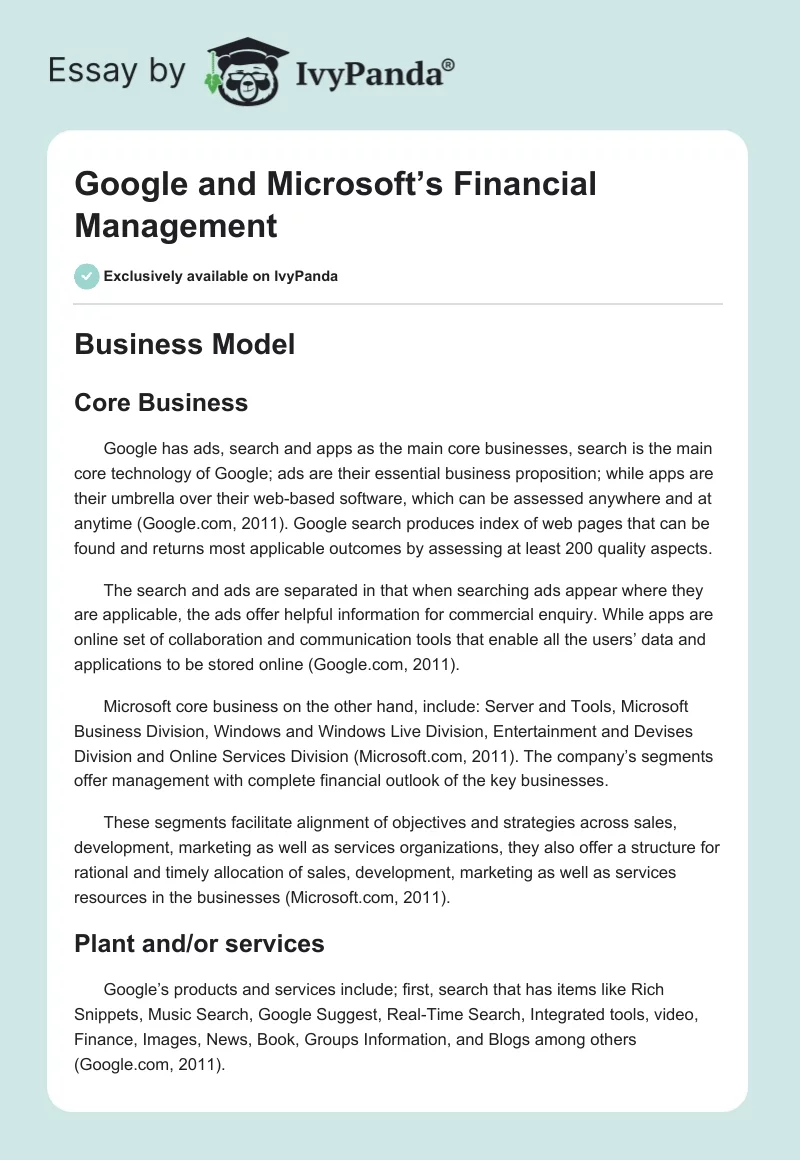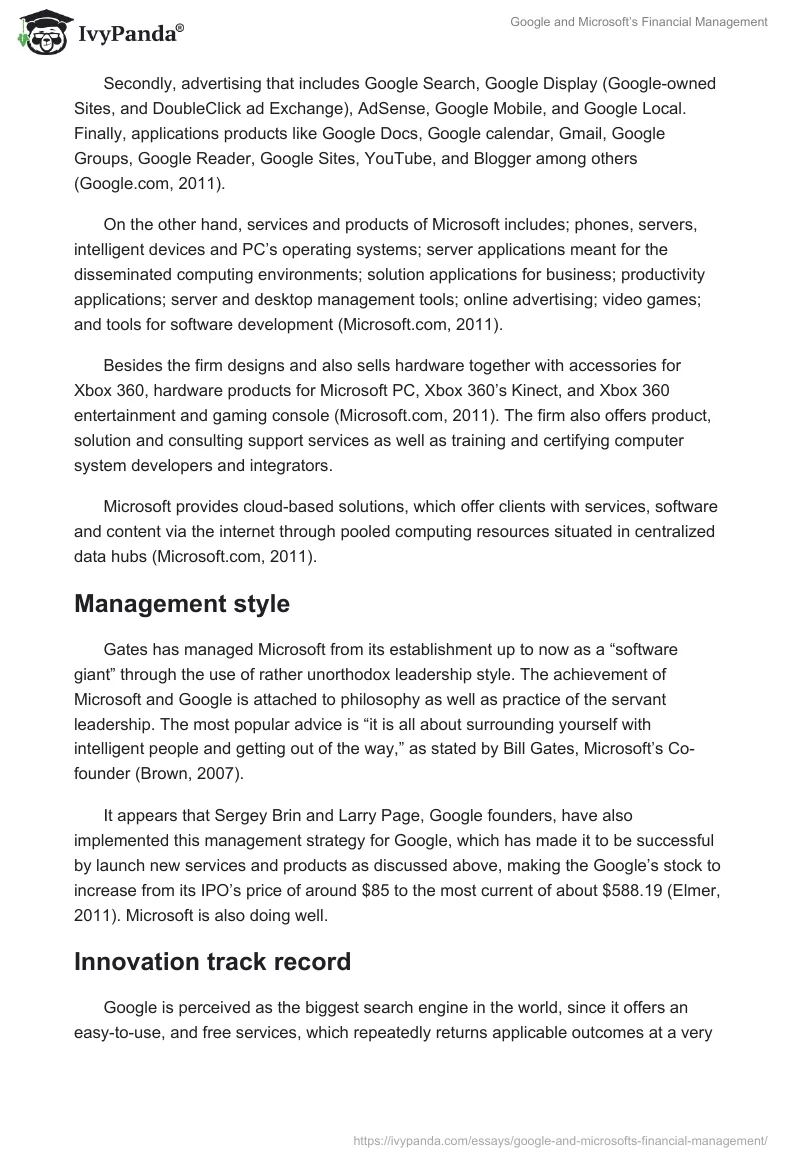Business Model
Core Business
Google has ads, search and apps as the main core businesses, search is the main core technology of Google; ads are their essential business proposition; while apps are their umbrella over their web-based software, which can be assessed anywhere and at anytime (Google.com, 2011). Google search produces index of web pages that can be found and returns most applicable outcomes by assessing at least 200 quality aspects.
The search and ads are separated in that when searching ads appear where they are applicable, the ads offer helpful information for commercial enquiry. While apps are online set of collaboration and communication tools that enable all the users’ data and applications to be stored online (Google.com, 2011).
Microsoft core business on the other hand, include: Server and Tools, Microsoft Business Division, Windows and Windows Live Division, Entertainment and Devises Division and Online Services Division (Microsoft.com, 2011). The company’s segments offer management with complete financial outlook of the key businesses.
These segments facilitate alignment of objectives and strategies across sales, development, marketing as well as services organizations, they also offer a structure for rational and timely allocation of sales, development, marketing as well as services resources in the businesses (Microsoft.com, 2011).
Plant and/or services
Google’s products and services include; first, search that has items like Rich Snippets, Music Search, Google Suggest, Real-Time Search, Integrated tools, video, Finance, Images, News, Book, Groups Information, and Blogs among others (Google.com, 2011).
Secondly, advertising that includes Google Search, Google Display (Google-owned Sites, and DoubleClick ad Exchange), AdSense, Google Mobile, and Google Local. Finally, applications products like Google Docs, Google calendar, Gmail, Google Groups, Google Reader, Google Sites, YouTube, and Blogger among others (Google.com, 2011).
On the other hand, services and products of Microsoft includes; phones, servers, intelligent devices and PC’s operating systems; server applications meant for the disseminated computing environments; solution applications for business; productivity applications; server and desktop management tools; online advertising; video games; and tools for software development (Microsoft.com, 2011).
Besides the firm designs and also sells hardware together with accessories for Xbox 360, hardware products for Microsoft PC, Xbox 360’s Kinect, and Xbox 360 entertainment and gaming console (Microsoft.com, 2011). The firm also offers product, solution and consulting support services as well as training and certifying computer system developers and integrators.
Microsoft provides cloud-based solutions, which offer clients with services, software and content via the internet through pooled computing resources situated in centralized data hubs (Microsoft.com, 2011).
Management style
Gates has managed Microsoft from its establishment up to now as a “software giant” through the use of rather unorthodox leadership style. The achievement of Microsoft and Google is attached to philosophy as well as practice of the servant leadership. The most popular advice is “it is all about surrounding yourself with intelligent people and getting out of the way,” as stated by Bill Gates, Microsoft’s Co-founder (Brown, 2007).
It appears that Sergey Brin and Larry Page, Google founders, have also implemented this management strategy for Google, which has made it to be successful by launch new services and products as discussed above, making the Google’s stock to increase from its IPO’s price of around $85 to the most current of about $588.19 (Elmer, 2011). Microsoft is also doing well.
Innovation track record
Google is perceived as the biggest search engine in the world, since it offers an easy-to-use, and free services, which repeatedly returns applicable outcomes at a very high speed. But the heart of it is advertising which is highly profitable, highly successful as well as highly innovative business model for improving advertising industry.
Along with an ever growing range of numerous new service and product establishments at the centre, Google’s main concentration is to utilize many of these in order to drive improved traffic to Google ever-increasing mobile, online, and soon-to-be offline, income flows from advertising.
Google commands almost 32% of the market share through AdWords and AdSense in the online advertising. As a result the firm’s stock prices have significantly increased (Innovationleaders.net, 2010).
Given the Microsoft’s scale, size as well as its success level, it is predictable for Microsoft to draw criticism.
For instance, the year 2007 was a bad year for the firm since European Commission and US Justice Department took action opposing the firm’s “monopolistic” practices as well as the media giggling about Zune, music offering, along with malfunctions in Vista whilst all together making threatening noises on the rise in unsettling rivalry from Google (Innovationleaders.net, 2010).
In spite of this, Microsoft earned $51 billion as revenue and carried on with innovation, remaining among the top 10 companies investing in Research and Development internationally.
Microsoft has a leading track record in the sector in acquisition of patents, keeps continued organic growth, provides work for about 79,000 individuals in 102 nations and is currently exploiting expertise as well as transformation through acquisition (Innovationleaders.net, 2010).
Financial ratio analysis
The liquidity ratio as measured by current ratio shows an increase in Google’s liquidity position from the year 2008 to 2009 but in 2010 the liquidity position declined implying that the firm was using more of the current liabilities.
On the other hand, Microsoft’s liquidity position improved throughout the three years (2008 to 2010) implying that the firm’s liquidity position was improving as it was using less of its current liabilities. In 2010, both firms’ liquidity positions were satisfactory since the ratio was more than one but Google was more liquid.
The profitability ratio as measured by Return on Assets shows that Google’s profitability position improved in 2009 by a margin of 2.79% to 16.10% while in 2010 the profitability declined to 14.70%. This means that in 2009, Google’s efficiency in the use of the firm’s asset to generate returns to the owners had improved but in 2010, Google was less efficient in generating returns to the providers of funds as shown by the drop in the ROA.
While as measured by Return on Equity, Google’s profitability increased from 14.97% to 18.11% in 2009, thus the firm’s ability to generate returns to equity shareholders from owners’ supplied funds had increased. The increase in profitability also increased in 2010 to 18.39% thus the firm’s efficiency with which it used the shareholders’ funds to generate returns had improved.
On the other hand, ROA ratio shows that Microsoft’s profitability position declined in 2009 by a margin of 5.58% to 18.71% this means that the firm’s efficiency of utilizing the owners’ assets to generate returns had declined.
But in 2010, the ratio improved implying that the firm’s efficiency with which it utilized its assets to generate returns to the providers of funds had improved. Similarly, ROE indicates the same trend of decline in 2009 and an improvement in 2010.
This means that there was a decline in profitability of the firm in 2009 and the firm’s inability to generate returns to shareholders from the owners’ supplied funds and vice versa for 2010. In general, Microsoft is more profitable than Google considering that the higher the ratio the higher the profitability of the firm.
The leverage ratio as measured by debt ratio indicates that Google’s gearing had increased throughout the three years. In 2008, 2009 and 2010 the firm raised 11.11%, 11.09% and 20.07% of debt from the total capital employed respectively. Google gearing level was satisfactory since the ratio in the three years was less than 50%. Its increase throughout the period was as a result of increase in liabilities.
Conversely, Microsoft was highly geared in 2008 as the ratio was more than 50% but the gearing level reduced in 2009 and further in 2010. Thus, in 2009 and 2010 the firm was not highly geared and the gearing level was satisfactory in the two years since it was less than 50%. Therefore, Microsoft is more geared compared to Google, implying that Microsoft has a higher financial risk.
Google’s efficiency with which it used its assets to generate sales increased in 2009 and declined in 2010 as measured by Fixed Asset Turnover ratio. This implies that in 2008, 2009 and 2010 the firm generated $1.88, $2.09 and $1.80 of sales from every dollar invested in fixed asset (see Appendix).
Conversely, Microsoft utilization of the assets to generate sales remained constant in 2008 and 2009 at $2.04 of sales for every dollar invested in fixed asset but in 2010 it increased to $2.05, indicating an improvement in efficiency with which the firm was converting assets into sales.
Thus, based on the higher the ratio the more efficient the firm is this means that Microsoft is more efficient in managing its assets than Google.
The evaluation ratio as measured by Dividend Payout ratio indicates that Google does not pay dividend this may be due to the reason that it is in the growth stage in its Life Cycle and it needs more cash to finance growth particularly in innovation.
While as measured by Price/Earnings ratio, Google’s investors in 2008, 2009 and 2010 would take 22.86, 30.07 and 22.25 years to recoup their initial investment in shares from the earnings generated by that investment in Google.
Conversely, Microsoft paid 23.16%, 31.90% and 24.41% of the earnings attributable to equity shareholders inform of dividends in 2008, 2009 and 2010 and retained 76.84%, 68.1% and 75.59% respectively. P/E ratio indicates that Microsoft’s investors in 2008, 2009 and 2010 will take 9.54, 17.85 and 12.77 years respectively, to recoup back their initial investment in the Microsoft’s shares from the firm’s earnings.
In general, Microsoft will withstand a major recession considering that interests are reduced at this time by the government, thus the firm will benefit from the use of more debt and its profitability and efficiency of managing assets will strengthen it during recession than Google.
Profitability
As discussed above Microsoft is more profitable than Google, this means that Microsoft’s management is more effective in generating returns from the assets employed as well as from the owners’ supplied funds. This means that it is able to meet its short term obligations and shareholders will obtain reasonable returns on their investments in form of dividends as well as capital gains.
On the other hand, Google is less profitable than Microsoft but it is able to meet its short term obligations; however, Google’s shareholders will not obtain reasonable returns on their investments in form of dividends, since Google is in its growth stage and its share price is very high with high volatility implying that the investors can benefit from the capital gains.
Therefore, this information can influence investors’ decisions in that those investors seeking long-term investments in order to earn dividends will go for Microsoft while those who are speculators and are not interested in dividends will go for Google in order to benefit from capital gains as a result of taking advantage of arbitrage pricing.
Financial-based guidelines
To select which of the two firms to invest in the investor should carry out a fundamental and technical analysis. Fundamental analysis considers factors like foreign and domestic economic and political events, government policies, weather and change of trade prospects as well as company’s financial statements. While technical analysis considers the share price movement and utilizes this data to forecast price movements in the future.
Investor should also consider own financial objectives, these objectives describe the investor’s expected returns and investment timeline (long-term or short-term). Finally, investor should consider risk-reward tolerance by determining their risk level and whether to diversify the risk by investing in both firms (Maxinvest.com, 2010).
References
Brown, K. (2007). Servant Leadership- A new model for the 21st century. Web.
Elmer, V. (2011). What would Larry Page do? Leadership lessons from Google’s doyen. Web.
Google.com. (2011). Business overview. Web.
Innovationleaders.net. (2010). Innovation leaders. Web.
Maxinvest.com. (2010). How do I choose a company to invest in? Web.
Microsoft.com. (2011). Company information. Web.


